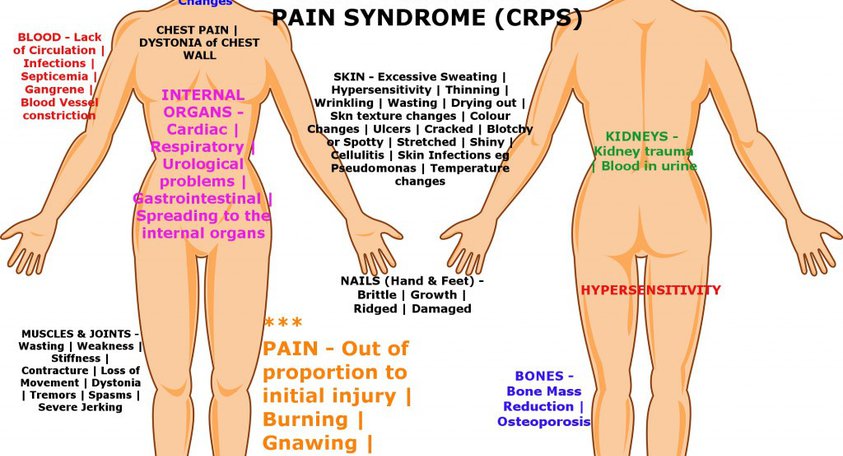We use cookies to improve your experience. By accepting you agree to our cookie policy

Complex Regional Pain Syndrome (CRPS) has a number of signs and symptoms, but not everyone living with CRPS will experience the same signs and symptoms as someone else with the condition. In effect, all CRPS patients are individuals where the signs and symptoms of CRPS are concerned, even though the treatments available are the same.
You may hear people refer to the 'Stages of CRPS', but these are considered obsolete, according to the RCP CRPS Guidelines (2018). This is because every person living with Complex Regional Pain Syndrome is different in terms of their particular symptoms of CRPS. See our 'FAQ' section at the bottom of this page.
Here we will discuss:
(See NHS Choices 'Complex Regional Pain Syndrome')
Below is an image showing the different Complex Regional Pain Syndrome symptoms that can affect CRPS patients.

How to get your symptoms assessed
We often get asked "Can CRPS spread?" The simple answer to this is that yes, CRPS can spread.
Data suggest that CRPS can spread outside of the originally affected limb, although this is not a universal phenomenon (Veldmen, P.H. & Goris, R.J 1996). This doesn’t mean that CRPS will spread in every patient. For some doctors and researchers, the 'spreading' of CRPS symptoms which are in the same area of the body or limb, is considered to be more likely to be related to myofascial pain syndrome.
It has widely been accepted by researchers that Complex Regional Pain Syndrome (CRPS) can spread from its initial site to other areas of the body. Although the cause of spreading CRPS symptoms is not clear, researchers have speculated that CRPS may spread by spinally or cortically mediated mechanisms (van Rijn.M.A. 2011).
Many CRPS patients are extremely fearful of the possibility of the CRPS spreading. From various research studies undertaken around the world, researchers such as Forss, N. et al (2005) say that: "The spread of chronic pain from its initial site of presentation is common…"
According to van Rijn, M.A. et al (2011): "One hundred and eighty-five CRPS patients were retrospectively evaluated. Cox’s proportional hazards model was used to evaluate factors that influenced spread of CRPS symptoms. Eighty-nine patients exhibited CRPS in multiple limbs. In 72 patients spread from a first to a second limb occurred showing a contralateral pattern in 49%, ipsilateral pattern in 30% and diagonal pattern in 14%."
In this van Rijn, M.A. et al (2011) retrospective study in 185 patients with CRPS (from a clinic specializing in treating CRPS associated with movement disorders) found that 48% reported spreading to another limb. Therefore, the results on the same research study from van Rijn, M.A. et al (2011) show that: "…CRPS usually affects one limb but in some cases it spreads to another limb, most often in a contralateral (53%) or ipsilateral (32%) pattern and usually without secondary trauma. A diagonal pattern of spread was nearly always triggered by a new trauma. Spontaneous spread and spread after a separate trauma followed different patterns."
In the same van Rijn, M.A. et al (2011) research article, the authors identified that: "The median interval between the occurrence in the first and second limb was 21 months for contralateral spread, 19 months for ipsilateral spread and 10 months for diagonal spread. The difference in intervals between contralateral and ipsilateral pattern was not significant."
What this means is that the average length of time between the different CRPS spreads are between 10 months - 21 months depending on which type of CRPS spread it is.
The van Rijn, M.A. et al (2011) is the largest systematic study of CRPS spreading (n=185) that suggests that contralateral spread is most common (mirror image spread), followed by ipsilateral spread (for example, CRPS symptoms hand to foot), or diagonal spread. All four limbs were affected in more than 29% of cases in this study. The two most common spreading patterns (ipsilateral and contralateral) developed on average 19 months or more after the initial onset of CRPS symptoms (Bruehl, S. 2015).
In a very small number of cases, which is thought to be 8% or less, Complex Regional Pain Syndrome has spread to the entire body. However, it is more common for CRPS to spread to an entire limb rather than the entire body or a contiguous spread.
As you have seen above there are a number of different ways that CRPS can spread. These include:
Also known as Mirror Image Spread, this is where the CRPS symptoms occur or appear on the opposite side of the body in the same or closest to the same location on the original CRPS area. For example, if the CRPS originally is in the left lower arm, the contralateral spread may occur in the right lower arm. Contralateral spreading of CRPS is thought to possibly arise via altered spinal processing of incoming sensory information in the spinal cord and brainstem (Brence, J. 2011).
This is where the CRPS symptoms spread or occur on the diagonally opposite part of the body to the original CRPS site. For example, if the CRPS is originally in the left arm, the CRPS symptoms may spread or occur in the right leg.
This is where the CRPS symptoms occur or spread on the same side of the body as the original CRPS area. For example, if the CRPS is in the left leg, the ipsilateral spread may occur in the left arm.
This is where the original CRPS site will gradually enlarge and grow bigger. It will most commonly move up the limb or area of the body.
This is where new symptoms of CRPS appear in a different area of the body away from the original CRPS area and where they are not attached or near the original CRPS site.
Not everyone in the medical community can agree of whether CRPS can spread to the internal organs. In the UK it is extremely difficult to get a connection made between your CRPS and any issue concerning your internal organs.
In a study (Dey S, Guthmiller KB, Varacallo M. [Updated 2023 Aug 7]) stated that there can be complications with CRPS including "..adrenal insufficiency, gastroparesis, and irritable bowel syndrome.."
According to Hooshmand, H. and Phillips, E. "CRPS invariably involves the internal organs. Usually the skin surface is cold at the expense of increased circulation to the internal organs. This increased circulation can cause osteoporosis, fractures of bone, complex regional pain syndrome abdomen cramps and diarrhea, disturbance of absorption of foods with resultant weight loss, water retention with aggravation of premenstrual headaches and depression, persistent nausea and vomiting, as well as severe vascular headaches mistaken for "cluster headache"."
Hooshmand, H. and Phillips, E. state that there are other complications involving the internal organs include:
Hooshmand and Phillips also say that Sympathetic Nerve Blocks can also cause complications for internal organs, including accidental trauma to the kidney with resultant hematuria (blood in urine) and aggravation of hypertension.
In another research article, Schwartzman, R.J. (2012) suggests that various internal organs can be affected by Complex Regional Pain Syndrome including the lungs. Out of a study of 270 CRPS patients, 15.5% complained of shortness of breath and that they could not take a deep breath, Schwartzmann, R.J. states that: "Dystonia of the chest wall muscles is common in severe long-standing patients…..Dystonia is a major component of the movement disorder of CRPS."
In a research study Irwin & Schwartzman ( 2011), they found that a CRPS patient had: "…developed painful dystonia of chest wall musculature."
In response to their finding, this patient was given intrathecal baclofen as a treatment for the dystonia in the chest wall and found that from this treatment: "…the patient had symptomatic relief and improvement of dystonia"
CRPS signs and symptoms, as well as patient history, will be used to diagnose the condition using the Budapest Criteria. If you have any of these signs and symptoms of CRPS and you haven’t been diagnosed with CRPS, please visit our How is CRPS Diagnosed? page for more information on how CRPS is diagnosed.
Please don't be tempted to diagnose yourself. Contact your GP or local doctor and tell them the signs and symptoms that you have having and if necessary ask for a referral to your local Pain Clinic.
If your CRPS signs and symptoms are starting to change or you have any new CRPS symptoms please seek an appointment with your doctor or pain clinic and let them know of your changes. You can also keep a pain diary to help you keep track of your signs and symptoms of CRPS and any changes that may be occurring.
Complex Regional Pain Syndrome (CRPS) has a large number of signs and symptoms, as you can see from the information on this page. Whether you look at the stages of CRPS or the signs and symptoms of CRPS you are able to see the effects on a CRPS sufferer. Every person living with Complex Regional Pain Syndrome (CRPS) won't have the same signs and symptoms as other CRPS patients. Even though CRPS can affect anyone, each patient is an individual where their symptoms and signs of CRPS are concerned.
*The information, descriptions, facts and figures given on this website are not meant to be used in any legal matters. They are for information purposes only. We are not doctors or medically trained. Please seek medical advice if you have any signs and symptoms or any changes of your condition.*
*All images are copyright*

You may hear people or doctors talking about "Stages of CRPS". The stages of CRPS are no longer used by the medical community because they are not considered reliable and therefore are not used any more. This is because not every CRPS patient will go through the Complex Regional Pain Syndrome stages, not everyone will go through the stages in sequence, some Complex Regional Pain Syndrome patients will stay in one of the stages and some patients don’t go through the stages at all.
There are 3 or 4 stages depending on which research you look into.
We use cookies to improve your experience. By accepting you agree to our cookie policy
 £
£